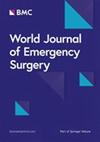多发伤后心脏损伤:系统经胸超声心动图的作用-一项初步研究
IF 5.8
1区 医学
Q1 EMERGENCY MEDICINE
引用次数: 0
摘要
多发伤后心脏损伤(PT)被认为是预后不良的预测因素。创伤后心脏损伤的诊断算法包括全身测量心脏损伤标志物,3通道心电图,如果有任何可疑发现,经胸超声心动图(TTE)传导。本研究的目的是在pt患者中应用TTE对心功能进行系统分析。该研究是一项前瞻性非随机研究,于2024年1月至7月在德国一级创伤中心进行。所有ISS≥16的多重创伤患者在进入急诊科后立即纳入。在急诊室、入院后24小时、48小时、3天、5天和10天等6个时间点抽取血样。通过肌钙蛋白T (TnT) ECLIA和NT-proBNP测量测量心脏损伤。进入重症监护室,由经验丰富的心脏病专家在两个时间点(第1天和第2天)进行经胸超声心动图检查。在试点阶段,14.3%的患者检测到心挫伤,与未发生心挫伤的患者相比,到达时、24小时(**p≤0.01)和48小时(*p≤0.05)时TnT水平均显著升高。超声心动图结果显示,25%的患者有壁运动异常,20%的患者有放松障碍。创伤患者通过TAPSE(三尖瓣环平面收缩偏移)、RVEDD(右心室舒张末期内径)和sPAP(收缩期肺动脉压)测量的右心室功能轻微受损,而左心室功能(射血分数(EF)和左心室舒张末期内径(LVEDD))得以保留。随着时间的推移,我们观察到TnT和心力衰竭标志物NT-proBNP的增加。这些生物标志物与先前存在的心脏危险因素、ISS和左右心室功能的变化有关。二尖瓣(1级)功能不全50%,三尖瓣(1级)功能不全30%。综上所述,我们首次对pt患者进行了系统的TTE分析。我们观察到患者右心室功能轻微降低,二尖瓣和三尖瓣反流。本文章由计算机程序翻译,如有差异,请以英文原文为准。
Cardiac damage after polytrauma: the role of systematic transthoracic echocardiography - a pilot study
Heart injuries following polytrauma (PT) are identified as a predictor of poor outcome. The diagnostic algorithm of cardiac damage after trauma consists of the systemic measurement of cardiac damage markers, a 3-channel ECG and if there are any suspicious findings, the conduction of a transthoracic echocardiography (TTE). The aim of this study was to implement a systematic analysis of cardiac function using TTE in PT-patients. This study is a prospective non-randomized study, conducted in a German Level 1 Trauma Centre between January and July 2024. All polytraumatized patients with an ISS ≥ 16 were included immediately after entering the emergency department. Blood samples were withdrawn at 6 timepoints, at the Emergency room, 24 h, 48 h, three, five and ten days after admission to the hospital. Cardiac damage was measured by Troponin T (TnT) ECLIA, as well as NT-proBNP measurements. Entering the intensive care unit, transthoracic echocardiography was performed at two time points (day 1 and 2), by an experienced Cardiologist. During the pilot phase, cardiac contusion was detected in 14.3% of patients, with significantly elevated TnT levels on arrival, after 24 (**p ≤ 0.01) and 48 h (*p ≤ 0.05) compared to patients without cardiac contusion. Echocardiographic findings revealed that 25% of all patients had wall motion abnormalities, and 20% showed relaxation disorders. Right ventricular function, measured by TAPSE (tricuspid annular plane systolic excursion), RVEDD (right ventricular end diastolic diameter) and sPAP (systolic pulmonary arterial pressure), was slightly impaired in trauma patients, while the left ventricular function (ejection fraction (EF) and left ventricular end diastolic diameter (LVEDD)) was preserved. We observed the increase of TnT and an increase of the heart failure marker NT-proBNP over the time. These biomarkers were associated with pre-existing cardiac risk factors, the ISS and changes in the right or left ventricular function. Mitral valve insufficiency (grade 1) was present in 50% and tricuspid valve (grade 1) insufficiency in 30%. Taken together, we conducted for the first time of our knowledge, a systematic TTE analysis in PT-patients. We observed a slightly reduced right ventricular function, as well as mitral and tricuspid valve regurgitations in the patients.
求助全文
通过发布文献求助,成功后即可免费获取论文全文。
去求助
来源期刊

World Journal of Emergency Surgery
EMERGENCY MEDICINE-SURGERY
CiteScore
14.50
自引率
5.00%
发文量
60
审稿时长
10 weeks
期刊介绍:
The World Journal of Emergency Surgery is an open access, peer-reviewed journal covering all facets of clinical and basic research in traumatic and non-traumatic emergency surgery and related fields. Topics include emergency surgery, acute care surgery, trauma surgery, intensive care, trauma management, and resuscitation, among others.
 求助内容:
求助内容: 应助结果提醒方式:
应助结果提醒方式:


